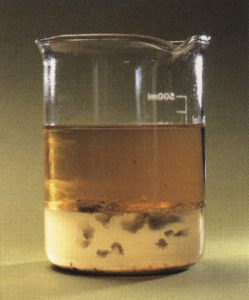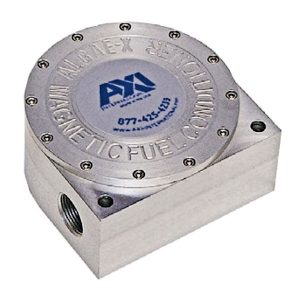Clogged Filters, Dirty Tanks
Most Engine Failures Originate in the Fuel Tank

Clogged filters and the need for frequent fuel filter changes should not be viewed as normal when operating diesel-powered vehicles or equipment. Although viewed by many as acceptable periodic maintenance, it is in fact a warning signal. Filter elements should last a thousand hours or more. Injectors should last some 15,000 hours. However, since fuel is inherently unstable, solids begin to form and the accumulating tank sludge will eventually clog your filters.
Fuels and oils are susceptible to natural deterioration, like any other organic fluid. Oxidation, chemical incompatibility, water and microbes all contribute to the process of polymerization and stratification. This results in poor fuel quality, tank sludge, bio film and acids. These by-products of the process of fuel breakdown cause:
- clogged filters
- corroded injectors
- shortened fuel pump life
- debris accumulation in tanks
- incomplete combustion
- carbon build-up
- excessive exhaust smoke
- loss of power
- ultimately leading to complete engine failure
Filters and centrifuges remove particles and free water, and biocides are recommended by many mechanics to control microbial activity. Neither, however eliminates fuel instability or sludge buildup, and biocide additive treatments frequently aggravate filtration problems. The solution is the LG-X Series Fuel Conditioning Technology. Fuel Conditioners reverses the process of fuel breakdown, restores fuel filterability, enhances combustibility, and prevents clogged filters & tank sludge.
Even with the use of biocides in an attempt to treat microbial contamination, only one source of the diesel fuel degradation is addressed. Solids will still form in the tank as the result of the inherent instability of the diesel fuel and the natural process of degradation. These solids accumulate in the bottom of your tank. The sludge will form a coating or bio-film on the walls and baffles of the tank, plug your filters and impact combustion efficiency. Eventually it will clog fuel lines and ruin your equipment.
Development of Microbial Growth in Fuels
Microbial contamination is not specific to any one fuel type. All marine, aviation, automotive and home heating fuels are susceptible. Similarly there is no single specific organism that can be identified as being responsible for degradation and spoilage. As a general rule, whenever fuel and water come into contact in a storage or distribution system microbial contamination is likely to occur. Long-term storage, such as for backup or emergency generators, is especially susceptible.
No matter how well a storage system is maintained, and regardless of whether it is your pickup truck fuel tank or a large fuel storage tank, a water bottom (water accumulation in the bottom of the fuel tank) is almost invariably present. This results from a number of sources:
- Freshly refined fuel contains some water. This separates out as the fuel cools down.
- Atmospheric condensation: humidity in the air in the storage tank condenses out and adds to the water bottom.
- Rain or snow may enter the tank via sampling ports, breather vents or ill-fitting seals on floating roofs of storage tanks.
- Transport or storage in tankers or barges can result in contamination from ballast water.
In addition, certain end use applications, notably marine fuel, provide opportunities for water to enter a storage system. Water from any of these sources accumulates in the storage tank to form the water bottom.
Microorganisms can be air or waterborne. Consequently as the water bottom develops a microbial population builds up in it. For many of the species present in the water bottom, liquid hydrocarbon fuels represent an excellent nutrient source. As a result there is a population explosion: the microorganisms proliferate at the fuel/water interface, surviving in the water phase whilst feeding on the fuel.
In the initial stages of contamination the organisms present are predominantly aerobic, using the dissolved oxygen in the water for respiration. As this supply of oxygen is depleted, anaerobic organisms, known as sulphate reducing bacteria, develop. These organisms do not require oxygen for respiration and form corrosive waste products such as hydrogen sulphide.
Consequences of Fuel Degradation
Once a microbial population becomes established fuel quality rapidly deteriorates. As Problems such as haziness, failure to meet specifications, corrosion, filter clogging and additive degradation can occur. All of these problems are related directly to the presence of microorganisms or their associated by-products.
Fuel Haziness — This is a clear indication that fuel is out of specification. The primary cause of haziness is an increase in the water content of the fuel resulting from the production of biosurfactants. These are by-products of microbial growth and alter the surface tension at the fuel/water interface. As a consequence the solubility of water in the fuel is increased.
Degradation of Additives — Certain additives, especially those rich in nitrogen and/or phosphorous, encourage microbial growth. In the process the additives are degraded and consequently their effect is lost.
Degradation Induced Corrosion — Hydrogen sulphide is produced by sulphate reducing bacteria. This enters solution and is highly corrosive, causing severe pitting of fuel tanks, pipe work and engine components.
Sludge Formation — Debris is deposited on the tank bottom where it forms a layer of sludge. This sludge creates an environment which favors microbially induced corrosion. It may also become contaminated with viable microorganisms and unless removed will act as a reservoir of infection every time the tank is used.
Clogged Filters — Biopolymers are formed during microbial growth. These are gummy byproducts which, along with microbial and other debris, are deposited on filters and pipes leading to reduced flow rates and blockages. At the end user level this can have serious consequences causing engine damage and in extreme cases complete failure.
Odor — A problem commonly associated with microbially contaminated fuel is that of foul odor. This is principally as a result of hydrogen sulphide production by sulphate reducing bacteria.
Other Factors Influencing Microbial Contamination
Although microbial spoilage and contamination occurs in a wide range of fuel types, some have been found to be more susceptible than others. For example, straight chain paraffins tend to be more readily degraded than aromatics and olefins.
The duration and conditions of storage are also important. If there is a low turnover of a stored fuel, such as in a strategic reserve, contamination is much more likely to develop. Poorly maintained or outdated storage facilities also present greater opportunities for contamination.
In the majority of cases, in addition to the microbial contamination at the fuel water interface there is a sessile population attached to the tank walls. This is frequently overlooked. Unless treated it will act as an innoculum reservoir for future contamination.

LG-X Series Fuel Conditioner
How the LG-X Series Fuel Conditioner works
LG-X Fuel Conditioner (MFC) technology operates on the principle of induction in the process of combining kinetic and magnetic energy to influence the behavior of electrons. The LG-X provides a powerful magnetic field and the flow of fuel provides the kinetic energy.
As fuel deteriorates, clusters of fuel components and other fuel breakdown residue begin to accumulate, resulting in dark, hazy fuel with poor combustibility. The increase in size and mass of the fuel breakdown products lead to clogged filters and the build up of tank sludge (sometimes erroneously referred to as algae).
Diesel engines return excess fuel not used for combustion back to the tank. This enables the LG-X, installed inline on the fuel line before the primary filter or on a fuel re-circulation system, to treat the fuel and keep the entire system clean.
In high-turnover fuel/oil terminals the LG-X is installed between the loading dock and the primary filter banks. In long-term storage the LG-X is installed in re-circulating systems to prevent fuel degradation and sludge build up.
As the fuel circulates through the LG-X unit, the fuel is polished, the clusters are dissolved, the fuel is stabilized, and tank sludge is eliminated. The results are clean fuel systems, Clear & Bright Fuel, improved filterability and optimal combustion.
LG-X units are self-cleaning and easy to install, have no moving parts, no electrical hookup, require zero maintenance, and are made in the U.S.A.. Units are available from 1/4″ port size with a flow up to 25 gph, up to 2″ port size (and larger) with a flow rate of 2500 gph.